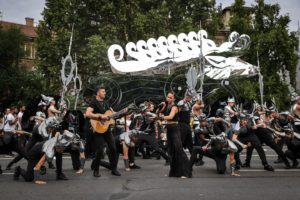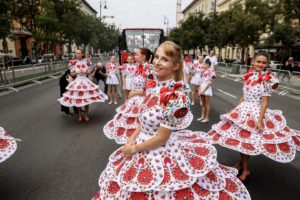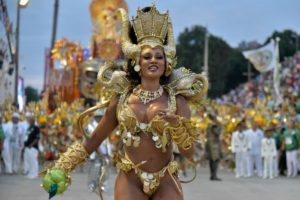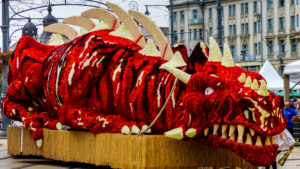Exclamations dripping with caustic sarcasm, condescending squeals and carving rhymes of agony - that's all the progressives managed to bring together after the tradition-creating St. Stephen's Day parade, which evoked the figures of Hungarian folklore and national symbols for the first time this year.
The audience could see the August 20 production between Oktogon and Hősök tere, where unique sculptures and well-known artists brought to life the history of Hungary's founding. But not everyone was pleased with the carnival-themed show, a bunch of opposition politicians and critics expressed their displeasure at the tasteless installations and visual elements, starting with the pink/purple/magenta turul and ending with the statue of St. István. With a shrug of the shoulders, we could of course say that it's a matter of taste, but here it's something else.
The purpose of the events is always to convey some kind of content, and this is sometimes achieved with verbal, sometimes formal elements, and sometimes with a mixture of the two. The origin of carnivals, for example, goes back to ancient times. The Greeks organized days-long carnivals in honor of Dionysus and the Romans in honor of Bacchus. Then, in the Middle Ages, carnival was the scheduled rite of institutionalized chaos, the world turned upside down around food, sex and violence, and the first Rio Carnival was held in 1723, and the Portuguese immigrants hardly thought that their celebration would be held three centuries later later it grows into an allegorical event with a global reach - and today it is one of the biggest attractions in the world.
Then there are the parades organized by homosexuals (LGBT), which, using banners and spectacular show elements that offend many, send a message to the world that sexual deviance is something to be celebrated today and something to be proud of. The first gay parade was held in New York in 1970, and since then parades have been organized in many major cities around the world, and the progressive world has already donated an entire summer month to Pride. It is worth highlighting here that while the vast majority of parades and carnivals take a stand for something without harming others, Pride - due to its essence - cannot do anything else - against something.
In a narrower cross-section, the Debrecen Flower Carnival is also a spectacular event loved by many of us, where both young and old can find dazzling flower installations close to their hearts, and although the first parade was officially organized only on August 20, 1966, the initiative itself dates back to 1905. when there was an invitation to found the Debrecen Mentő Egyesület.
Celebrations, parades, and carnivals are therefore never without colorful, spectacular show elements, just as the colors and forms of the circus, revue, or even ice dancing cannot be integrated into everyday life: the goal is to stand out from it. Of course, the sight of attention-grabbing, fairytale-like, often challenging installations, painted human bodies and glittering sequins can be classified as kitsch and tasteless, but then it is appropriate to say that all parades, from the Rio Carnival to Budapest Pride, are kitsch and tasteless, since they all operate with the same formal elements , only the content changes. And here we come to the point, to the fact that with the statements dripping with caustic sarcasm, with which they criticized the St. Stephen's Day parade, they did not really communicate the form: they were not concerned with the metal turule and the resplendent gold statue of St. Stephen, but specifically with the turul and Szent István.
Rita Perintfalvi, a feminist theologian (?), who believes that Jesus, if he were alive today, would go to Pride , said the following about the event:
"I really have no problem with the Turul bird and Emese, whom he allegedly impregnated in a dream. And I don't have a problem with these handsome boys, just like I don't have a problem with the gold-clad St. Stephen who wears C-3PO. I just find it somehow surreal and eclectic. Because right now it was either the Turul bird that impregnated Emese or the Holy Spirit the Virgin Mary?”
In the columns of Népszava, Ildikó Lendvai in his article Gurul a turul :
"Our government felt it was its duty to replace the old May Day with something. Then it was a parade, now it's a roll-up. I just don't understand where the tribune is left, from where the prime minister could have waved to Szent István. I still understand that you didn't want to roll at the head of the procession, that a prime minister would look like a children's push-and-click duck on wheels."
There is a certain discreet charm when the communists' number one female censor under a right-wing government mocks an event held on August 20, meaning no one was trampled to death and no monster died, drawing a devastating parallel with a system in which she unknowingly he could lick. This is mind splitting at its best!
And the irony is that from here, with just one hussar cut, he reaches the migration pressure that followed the Taliban takeover and aimed at (also) Europe, which, according to him, "could be a found treasure for the Orbáns". It seems that Ildikó, as befits a good Stakhanovist, overachieves even today, and with this article he wanted to kill two birds with one stone.
But Gyurcsány could not be left out of the reviewers, who testifies to his toothless historical knowledge not for the first time:
"Szent István's turul is towed for 6.5 billion in Legion to the Colosseum via Budapest:)) They got lost. In every way.”
Zita Gurmai's son, writer and publicist Balázs Gulyás speculates about one of the installations (Can Dodzsemszentistván and the Nemválló Turul be loved)
"On Thursday, a few photos of the magenturul, our totem animal dressed in pink, ran all over Hungarian social media. As it turned out later in the afternoon, the magenta shade on the 4.5-meter-high statue is only the color of the covering film, the organizers made the mistake of not covering the matenir, which had already been pulled out yesterday, with some kind of shroud in order to avoid spoilers, and on the other hand, when Thursday morning from the first mistake everyone was talking about this next, they didn't prevent the PR disaster, they reacted late, they announced too late that the pink color is only the covering plumage of the bird, which is tasteless at the same time, meant to prevent injuries."
I note that this line of thought is particularly remarkable because it includes the dead-end mentality associated with stupidity of the Hungarian opposition and their media workers. First of all, the author is so stupid that in this age of high technology, he cannot identify a protective film covering every new scratch-sensitive surface, from smartphones to monitors. Then, after being confronted with his stupidity, instead of admitting it, or at least remaining silent, he goes on the attack, because he is arrogant enough to blame others for his own shortcomings. Finally, after a long pause, he reveals that he thinks the installation is tasteless, and finally, inspired by his own genius, he creates a montage for himself - Orbán obviously falls for it.

Source: Facebook
The Telex Metálturul, rolling Szent István and a Hip Hop Boyz song also appeared on the national kitsch festival, in a similar tone of writing, he summarized what he saw:
"Szent István rolls in front of me, golden up to his feet, with folk dancers walking and smiling in his wake. Behind the scenes, there is a man sitting locked in the statue - probably hunched over - he is driving the St. Stephen's carriage."
The person crouched down and locked in a statue is a feature of the domestic dictatorship - if the dear Reader did not know this by now. He would also have wondered that the key to the statue prison could only be kept by Orbán himself, under seven locks, in a secluded room of the Carmelite monastery.
Gergely Gulyás, the minister in charge of the Prime Minister's Office, was close to the truth in his answer when he answered a journalist's question about the events of August 20 - specifically the fireworks - at last Saturday's extraordinary government briefing:
"It's even more fun when people who personally attend Pride call the fireworks, where the Holy Crown and a cross appeared, a kitsch parade."

Source: PS
And sure enough, he's right. For those opposition politicians and commentators who proudly display themselves at Pride with a rainbow flag in their hands (and often get offended if their Hungarianness is questioned), tasteless kitsch hardly causes a headache. And here's where the dog is buried: they want to be Hungarians in such a way that there is no trace of Hungarianness as an entity.
Featured image: Blikk / Péter Zsolnai







































